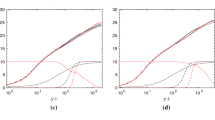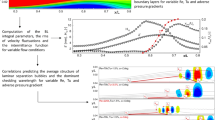Abstract
The paper presents some results of application of a low-Re-number second-moment closure (SMC) to modelling the laminar-to-turbulent transition induced by a separation bubble. The same model, tested earlier in a number of low and high-Re-number flows, was found also to reproduce reasonably well several cases of bypass transition, as well as cyclic sequence of laminarization and turbulence revival in oscillating flows at transitional Re numbers, without any artificial transition triggering. The focus of the paper is on separation-induced transition in flow over a flat plate with a circular leading edge, and on a plane surface on which a laminar separation bubble was generated by imposed suction on the wall-opposite boundary. The results show acceptable agreement with available experimental data, large-eddy and direct numerical simulations (LES, DNS). The importance of applying higher-order discretization schemes for reproducing both the bubble and the transition is also discussed.
Similar content being viewed by others
References
Alam, M. and Sandham, N.D., Direct numerical simulations of short laminar separation bubbles. J. Fluid Mech. 403 (2000) 223-250.
Chen, W.L., Lien, F.S. and Leschziner, M.A., Computational modelling of turbulent flow in turbomachine passage with low-Re two-equation models. In: Computational Fluid Dynamics '94. Stuttgart, Germany (1994) pp. 517-524.
Coupland, J., Personal Communication (1995).
Craft, T., Launder, B.E. and Suga, K., Prediction of turbulent transitional phenomena with a nonlinear eddy-viscosity model. Internat. J. Heat Fluid Flow 18 (1997) 15-28.
Craft, T.J., Second-moment modelling of turbulent scalar transport. Ph.D. Thesis, UMIST, Manchester, U.K. (1991).
Gibson, M.M. and Launder, B.E., Ground effects on pressure fluctuations in the atmospheric boundary layer. J. Fluid Mech. 86 (1978) 491-511.
Hanjalić, K. and Hadžić, I., Modelling the transition phenomena with statistical turbulence closure models. In: Henkes, R.A.W.M. and van Ingen, J.L. (eds), Transitional Boundary Layers in Aeronautics. North-Holland, Amsterdam (1996) pp. 283-294.
Hanjalić, K., Hadžić, I. and Jakirlić, S., Modeling turbulent wall flows subjected to strong pressure variations. ASME J. Fluids Engrg. 12 (1999) 57-64.
Hanjalić, K. and Jakirlić, S., Contribution towards the second-moment closure modelling of separating turbulent flows. Comput. & Fluids 27(2) (1998) 137-156.
Hanjalić, K., Jakirlić, S. and Hadžić, I., Computation of oscillating turbulent flows at transitional Re-numbers. In: Durst, F., Kasagi, N., Launder, B.E., Schmidt, F.W., Suzuki, K. and Whitelaw, J.H. (eds), Turbulent Shear Flows, Vol. 9. Springer-Verlag, Berlin (1995) pp. 323-342.
Hanjalić, K., Jakirlić, S. and Hadžić, I., Expanding the limits of “equilibrium” second-moment turbulence closures. Fluid Dynam. Res. 20 (1997) 25-41.
Hanjalić, K. and Launder, B.E., Sensitizing the dissipation equation to irrotational strains. ASME J. Fluids Engrg. 102 (1980) 34-40.
Lien, F.S. and Leschziner, M.A., Approximation of turbulence convection with a TCD scheme. In: 5th International Symposium on Refined Flow Modelling and Turbulence Measurements. Presses de l'école nationale des Ponts et Chaussés, Paris (1993) pp. 183-190.
Mayle, R.E., The role of laminar-turbulent transition in gas turbine engines. J. Turbomachinery 113 (1991) 509-537.
Papanicolau, E.L. and Rodi, W., Computation of separated-flow transition using a two-layer model of turbulence. J. Turbomachinery 121 (1999) 78-87.
Savill, A.M., Some recent progress in the turbulence modelling of by-pass transition. In: So, C.G.S.R.M.C. and Launder, B.E. (eds), Near-Wall Turbulent Flows. Elsevier Science, Amsterdam (1993) pp. 829-848.
Savill, A.M., Transition predictions with turbulence models. In: Henkes, R.A.W.M. and van Ingen, J.L. (eds), Transitional Boundary Layers in Aeronautics. North-Holland, Amsterdam (1996) pp. 311-319.
Spalart, P.R. and Strelets, M.K., Direct and Reynolds-averaged numerical simulations of a transitional shear bubble. In: Proceedings of 11th Symposium on Turbulent Shear Flows. Université Joseph Fourier, Grenoble, France (1997) pp. 30.13-30.18.
Spalart, P.R. and Strelets, M.K., Mechanism of transition and heat transfer in a separation bubble. J. Fluid Mech. 403 (2000) 329-349.
Yang, Z. and Voke, P.R., Large-eddy simulation of boundary layer transition on a flat plate with semi-circular leading edge. In: Proceedings of 10th Symposium on Turbulent Shear Flows. The Pennsylvania State University, University Park, PA (1995), pp. 11.13-11.19.
Author information
Authors and Affiliations
Rights and permissions
About this article
Cite this article
Hadžić, I., Hanjalić, K. Separation-Induced Transition to Turbulence: Second-Moment Closure Modelling. Flow, Turbulence and Combustion 63, 153–173 (2000). https://doi.org/10.1023/A:1009980119240
Issue Date:
DOI: https://doi.org/10.1023/A:1009980119240




